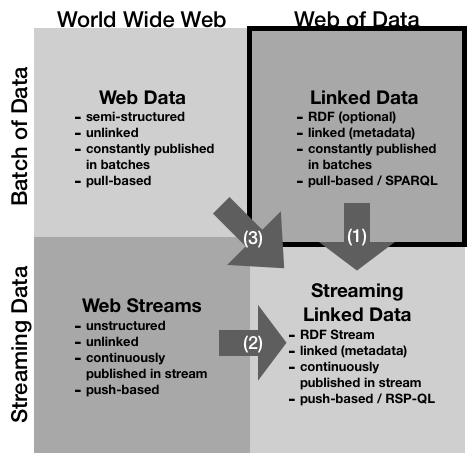Publishing DBPedia Live Updates as RDF Streams

- Web Stream
- 20 minutes
Ingredients
- Access to DBPedia Live Update
- A Text Editor
- An RML Mapping Engine
- Knowledge About OWL and RDF
- [Optional] an RSP engine to calculate some descriptive statistics
Directions
- Get access to DBPedia Live Updates
- Identify the publication case ( see Figure 1)
- Find the schema that is used for the messages, if any.
- Find/design an ontology to be used for conversion into RDF Stream
- Use the Text Editor to map the schema into a common ontology
- Using an mapping engine, apply the mapping on the fly
 Figure 1
Figure 1
Figure 1 shows the possible situations practitioners may find when they want to publish streams on the Web. The lower-right quadrant identifies our ultimate goal, i.e., Streaming Linked Data. The other quadrants presents possible starting points, i.e., (upper-left) Web Data published in batches; (upper-right) Linked Data published in batches; and (lower-left) Web Data published as streams.
The case of DBPedia Live Update (DBL) Stream is the one identified by the upper-right quadrant, i.e., a Web Stream that is not linked yet.
To proceed creating a Linked Data Stream we follow the publication pipeline included in the following Figure.
 Figure 2
Figure 2
DBL data are already in RDF. Thus, it is not necessary to set up any conversion mechanism. Nevertheless, it is relevant to identify which ontology/vocabulary is used as well as identify the structure of the streams.
DBL a changelog stream, i.e., the data represent changes to DBPedia and have the goal of keeping DBPedia replicas in-synch. A Synchronization Tool designed to consume the batches and update the local DBPedia copy is available.
The Stream, accessible via HTTP at is organized in four sub-streams:
- added, i.e., the RDF triples corresponding to added pages.
- removed, i.e., the RDF triples corresponding to removed pages.
- reinserted, i.e., RDF triples that need to be left unmodified after the update
- clear, i.e., only subjects of all added, removed and reInserted triples
The ontology used is DBPedia’s Ontology, which is generated from the manually created specifications in the DBpedia Mappings Wiki.
For the publication, we wrote the stream annotation using VoCaLS and we released it using TripleWave.
The following Listing presents the DBPedia Live VoCaLS Stream
Descriptor. It contains basic information about the publisher and the
license. We linked DBPedia ontology and other relevant datasets (lines
5-6). Finally, the VoCaLS file indicates an RSP engine accessible for
query answering using the vsd:publishedBy property.
1
2
3
4
5
6
7
8
9
10
11
:dbl a vocals:StreamDescriptor ; dcat:dataset :dblstream .
:dblstream a vocals:RDFStream ;
dcat:title "DPedia Live" ; dcat:publisher <http://www.dbpedia.org> ;
rdfs:seeAlso <http://downloads.dbpedia.org/2016-10/dbpedia_2016-10.owl>
rdfs:seeAlso <https://wiki.dbpedia.org/downloads-2016-10#datasets> ;
dcat:license <https://creativecommons.org/licenses/by-nc/4.0/> ;
vsd:publishedBy :RSPEngine .
:RSPEngine a vsd:ProcessingService ;
vsd:hasLang vsd:RSP-QL;
vsd:resultFormat frmt:JSON-LD ;
vsd:rspEndpoint "http://streamreasoning.org/yasper/queries" .
More delicious recipes
This is one of the many fantastic recipes available on this blog
